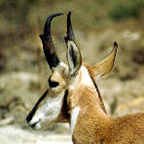Pronghorn (Antilocapra americana)

TPWD ©
- Description
- The antelope is a small, deerlike mammal with black, pronged horns on both males and females. They have only two toes on each foot. They have a distinctive black stripe along their nose and a white cheek patch. Males also have a black patch on their jaw. Females are usually somewhat smaller than males.
- Life History
- Among North American mammals, Pronghorns are the most fleet-footed. The top speed at which they can run probably does not exceed 70 km an hour, and certainly it varies with individuals. An interesting trait of Pronghorns is their highly developed sense of curiosity. They insist on examining at close range any unrecognized object, particularly one that is in motion. Because of this, it is possible for man to lure the animals within close range by hiding behind a bush and waving a handkerchief or other object slowly back and forth. Indians, and sometimes our present-day hunters, have utilized this ruse in bagging them.
Another peculiar trait is their disinclination to jump over fences or other objects. A low brush fence no more than a meter high will ordinarily turn the animals, and it is not uncommon for small bands to be reduced almost to the point of starvation within a fenced enclosure while plenty of food is available on the outside. They can jump over moderately high obstructions, however, when hardpressed. Ordinarily, they crawl under or between the wires of barbed-wire fences.
Antelopes feed and rest periodically throughout the day and night. Their diet consists entirely of vegetation, mostly shrubs and grasses. Pronghorns are especially fond of wildflowers and fruits and can eat some plants, such as paper flower and woolly senecio, that are poisonous to other animals.
The breeding season of the Pronghorn in Trans-Pecos Texas extends from late summer to early fall. The most strongest bucks gather small harems of two to 14 does. Young bucks frequently linger at the outskirts of the harem herd and at times attempt to steal a doe or even to interfere with a mature buck in his mating activities. The master of the harem has an endless task in keeping his does together and warding off intruding bucks.
When baby Pronghorns are born in the spring and early summer, the female hides her young ones and returns to them three or more times a day so they can nurse. They are able to walk and run when they are only about a week old. At one month old, they can easily graze on vegetation. Pronghorns can live to be as old as 12-14 years in the wild, but the average lifespan is probably considerably less. - Habitat
- The fleet-footed, large-eyed Pronghorn is an animal of the plains. Adapted for speed and for seeing long distances, it inhabits areas where both its sight and its running will be unimpaired by woodland vegetation. Water in the immediate vicinity is not a requisite because the Pronghorn is so adapted physiologically that it can go for long periods without drinking. Apparently, it has the ability to conserve body water and to produce metabolic water.
- Distribution
- Antelope are common throughout the high plains of North America. In Texas, they were once common over the western two-thirds of the state, ranging as far as Robertson County in the north and Kenedy County in south Texas. Now they are restricted to limited areas from the Panhandle to the Trans-Pecos.